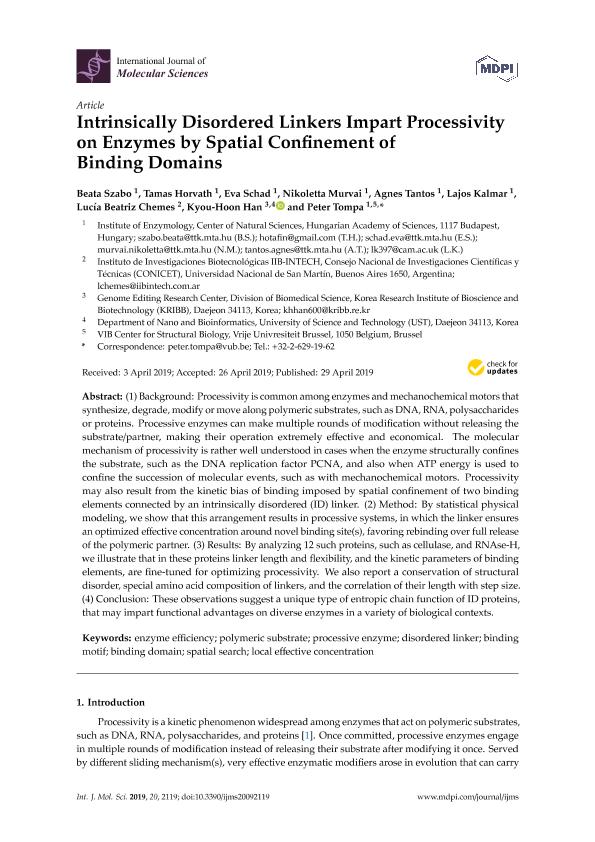Mostrar el registro sencillo del ítem
dc.contributor.author
Szabo, Beata
dc.contributor.author
Horvath, Tamas
dc.contributor.author
Schad, Eva
dc.contributor.author
Murvai, Nikoletta
dc.contributor.author
Tantos, Agnes
dc.contributor.author
Kalmar, Lajos
dc.contributor.author
Chemes, Lucia Beatriz

dc.contributor.author
Han, Kyou Hoon
dc.contributor.author
Tompa, Peter
dc.date.available
2022-02-04T18:36:56Z
dc.date.issued
2019-05
dc.identifier.citation
Szabo, Beata; Horvath, Tamas; Schad, Eva; Murvai, Nikoletta; Tantos, Agnes; et al.; Intrinsically disordered linkers impart processivity on enzymes by spatial confinement of binding domains; Multidisciplinary Digital Publishing Institute; International Journal of Molecular Sciences; 20; 9; 5-2019; 1-18
dc.identifier.issn
1661-6596
dc.identifier.uri
http://hdl.handle.net/11336/151382
dc.description.abstract
(1) Background: Processivity is common among enzymes and mechanochemical motors that synthesize, degrade, modify or move along polymeric substrates, such as DNA, RNA, polysaccharides or proteins. Processive enzymes can make multiple rounds of modification without releasing the substrate/partner, making their operation extremely effective and economical. The molecular mechanism of processivity is rather well understood in cases when the enzyme structurally confines the substrate, such as the DNA replication factor PCNA, and also when ATP energy is used to confine the succession of molecular events, such as with mechanochemical motors. Processivity may also result from the kinetic bias of binding imposed by spatial confinement of two binding elements connected by an intrinsically disordered (ID) linker. (2) Method: By statistical physical modeling, we show that this arrangement results in processive systems, in which the linker ensures an optimized effective concentration around novel binding site(s), favoring rebinding over full release of the polymeric partner. (3) Results: By analyzing 12 such proteins, such as cellulase, and RNAse-H, we illustrate that in these proteins linker length and flexibility, and the kinetic parameters of binding elements, are fine-tuned for optimizing processivity. We also report a conservation of structural disorder, special amino acid composition of linkers, and the correlation of their length with step size. (4) Conclusion: These observations suggest a unique type of entropic chain function of ID proteins, that may impart functional advantages on diverse enzymes in a variety of biological contexts.
dc.format
application/pdf
dc.language.iso
eng
dc.publisher
Multidisciplinary Digital Publishing Institute
dc.rights
info:eu-repo/semantics/openAccess
dc.rights.uri
https://creativecommons.org/licenses/by-nc-sa/2.5/ar/
dc.subject
BINDING DOMAIN
dc.subject
BINDING MOTIF
dc.subject
DISORDERED LINKER
dc.subject
ENZYME EFFICIENCY
dc.subject
LOCAL EFFECTIVE CONCENTRATION
dc.subject
POLYMERIC SUBSTRATE
dc.subject
PROCESSIVE ENZYME
dc.subject
SPATIAL SEARCH
dc.subject.classification
Biofísica

dc.subject.classification
Ciencias Biológicas

dc.subject.classification
CIENCIAS NATURALES Y EXACTAS

dc.title
Intrinsically disordered linkers impart processivity on enzymes by spatial confinement of binding domains
dc.type
info:eu-repo/semantics/article
dc.type
info:ar-repo/semantics/artículo
dc.type
info:eu-repo/semantics/publishedVersion
dc.date.updated
2020-11-20T18:10:19Z
dc.identifier.eissn
1422-0067
dc.journal.volume
20
dc.journal.number
9
dc.journal.pagination
1-18
dc.journal.pais
Suiza

dc.journal.ciudad
Basel
dc.description.fil
Fil: Szabo, Beata. Hungarian Academy of Sciences; Hungría
dc.description.fil
Fil: Horvath, Tamas. Hungarian Academy of Sciences; Hungría
dc.description.fil
Fil: Schad, Eva. Hungarian Academy of Sciences; Hungría
dc.description.fil
Fil: Murvai, Nikoletta. Hungarian Academy of Sciences; Hungría
dc.description.fil
Fil: Tantos, Agnes. Hungarian Academy of Sciences; Hungría
dc.description.fil
Fil: Kalmar, Lajos. Hungarian Academy of Sciences; Hungría
dc.description.fil
Fil: Chemes, Lucia Beatriz. Consejo Nacional de Investigaciones Científicas y Técnicas. Centro Científico Tecnológico Conicet - La Plata. Instituto de Investigaciones Biotecnológicas. Universidad Nacional de San Martín. Instituto de Investigaciones Biotecnológicas; Argentina
dc.description.fil
Fil: Han, Kyou Hoon. University of Science and Technology; Corea del Sur. Korea Research Institute of Bioscience and
Biotechnology; Corea del Sur
dc.description.fil
Fil: Tompa, Peter. Hungarian Academy of Sciences; Hungría. Vrije Unviversiteit Brussel; Bélgica
dc.journal.title
International Journal of Molecular Sciences

dc.relation.alternativeid
info:eu-repo/semantics/altIdentifier/doi/http://dx.doi.org/10.3390/ijms20092119
dc.relation.alternativeid
info:eu-repo/semantics/altIdentifier/url/https://www.mdpi.com/1422-0067/20/9/2119
Archivos asociados
